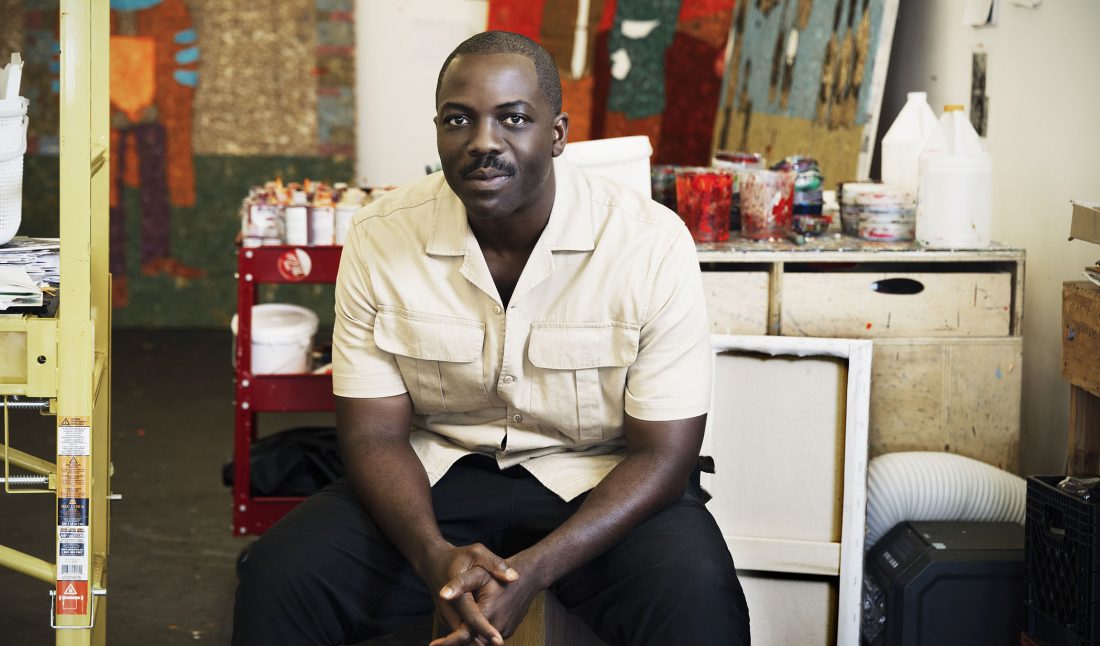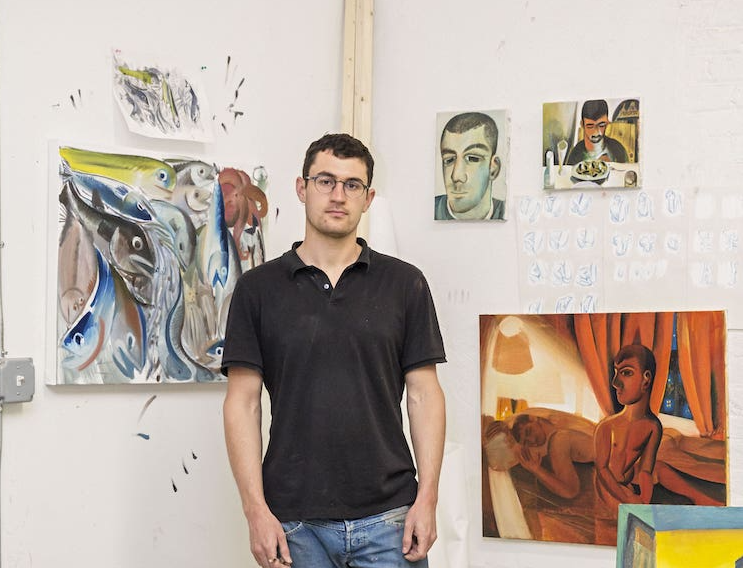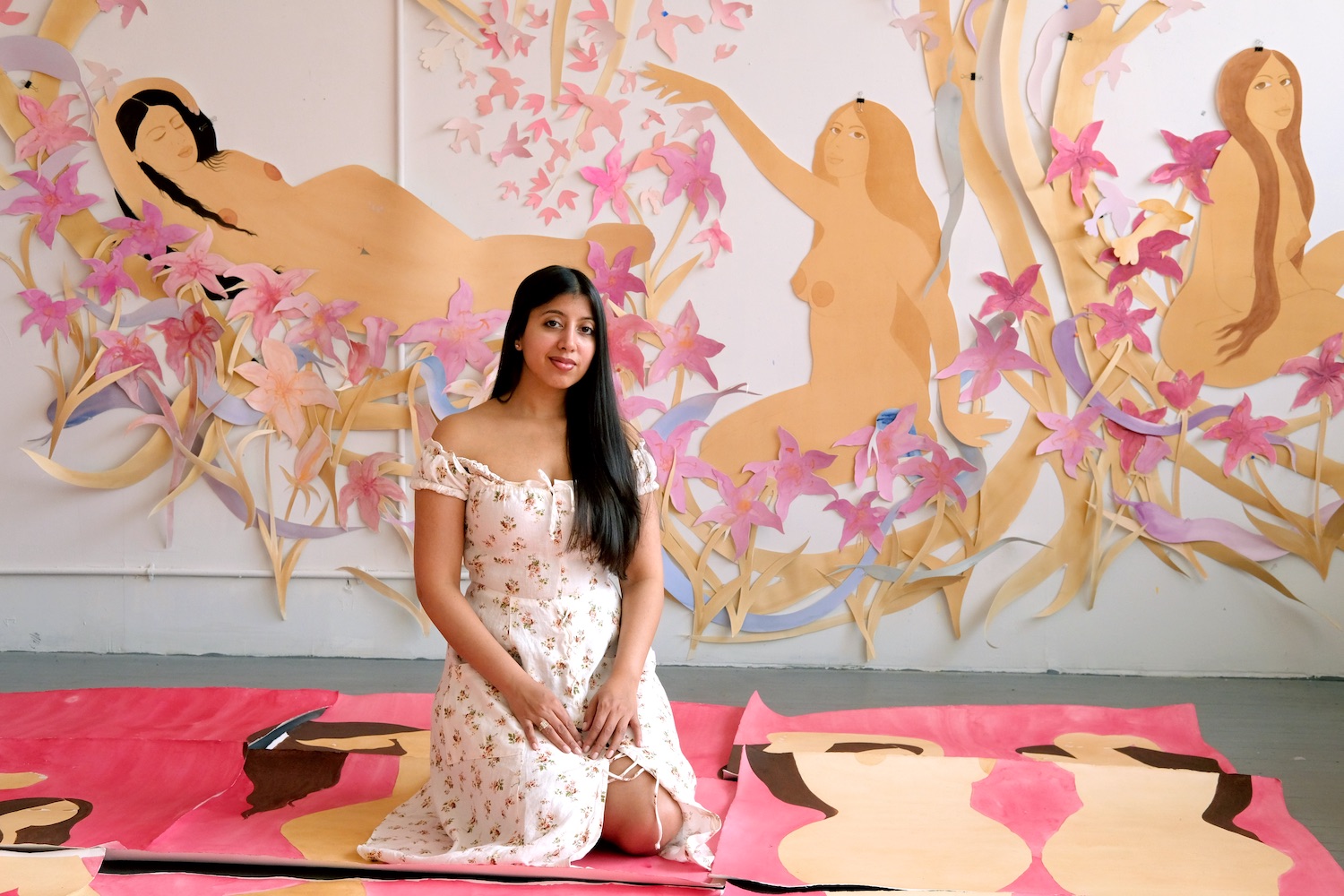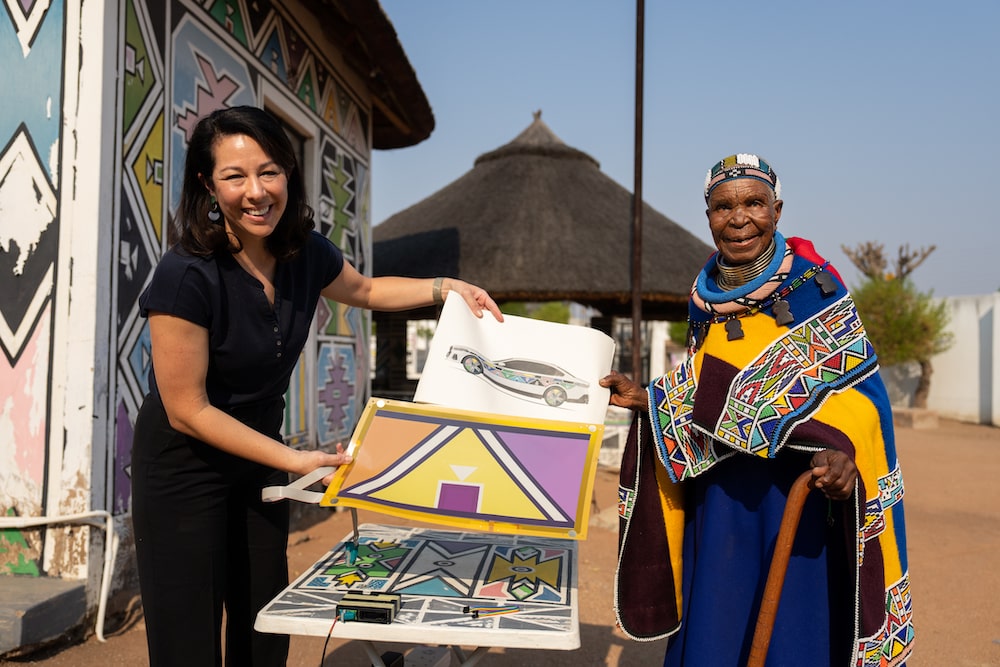Derek Fordjour’s Immersive New York Show
The multidimensional solo exhibition “SCORE” by Derek Fordjour is on view at Petzel Gallery in New York through December 22, 2023. The exhibition brings together new paintings, sculptural installations, kinetic vignettes, an indoor performance space in the round, and a two-floor gallery immersive architectural experience.
The New York–based artist is known for his paintings that are full of color, pattern, texture, and repetition of rhythm. They allude to and feature elements of performance, from musicians to swimmers, gymnasts to jockeys. This latest body of work, as Fordjour shared with Whitewall in a recent conversation, is his most vulnerable yet, referencing personal stories and his own journey as an artist.
It may also be the most involved in terms of production, engaging collaboration with actors, builders, dancers, the musician Hannah Mayree of the Black Banjo Reclamation Project, and the choreographer Sidra Bell. Fordjour finds himself in a place where he, always described as a painter, can fully embrace and express the multidisciplinary character of his practice—sculpture, installation, performance, and more.
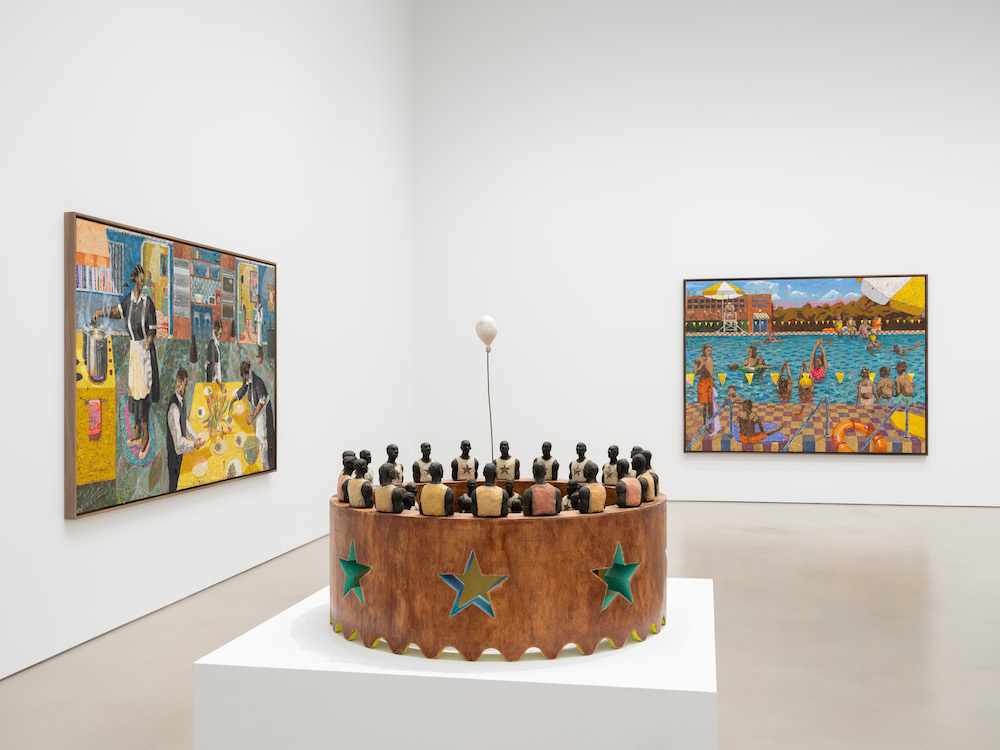 Installation view of Derek Fordjour’s “SCORE” on view at Petzel Gallery in New York.
Installation view of Derek Fordjour’s “SCORE” on view at Petzel Gallery in New York.
Fordjour shared with us about what it’s like to find himself celebrating a new level of maturity in his creativity, why he always likes to be in the position of learning, and contemplating the act of teaching as a form of love.
WHITEWALL: What was the starting point for your exhibition of new work at Petzel Gallery, “SCORE”?
DEREK FORDJOUR: I always respond to space. When I visited the new gallery at Petzel on 25th Street, it just registered in my body. A couple of months later, my brain starts to populate with ideas for the space, and it wasn’t much long after that I had a fully baked idea of what I wanted to go where. I had a general framework pretty early.
I’m always turning over content in relation to my works, and I have tons of ideas for shows and paintings that are laying around in my mind. The content that made sense was about where I am right now and the conversation I want to have right now. I try to make shows that are up to the minute on where I am in my life.
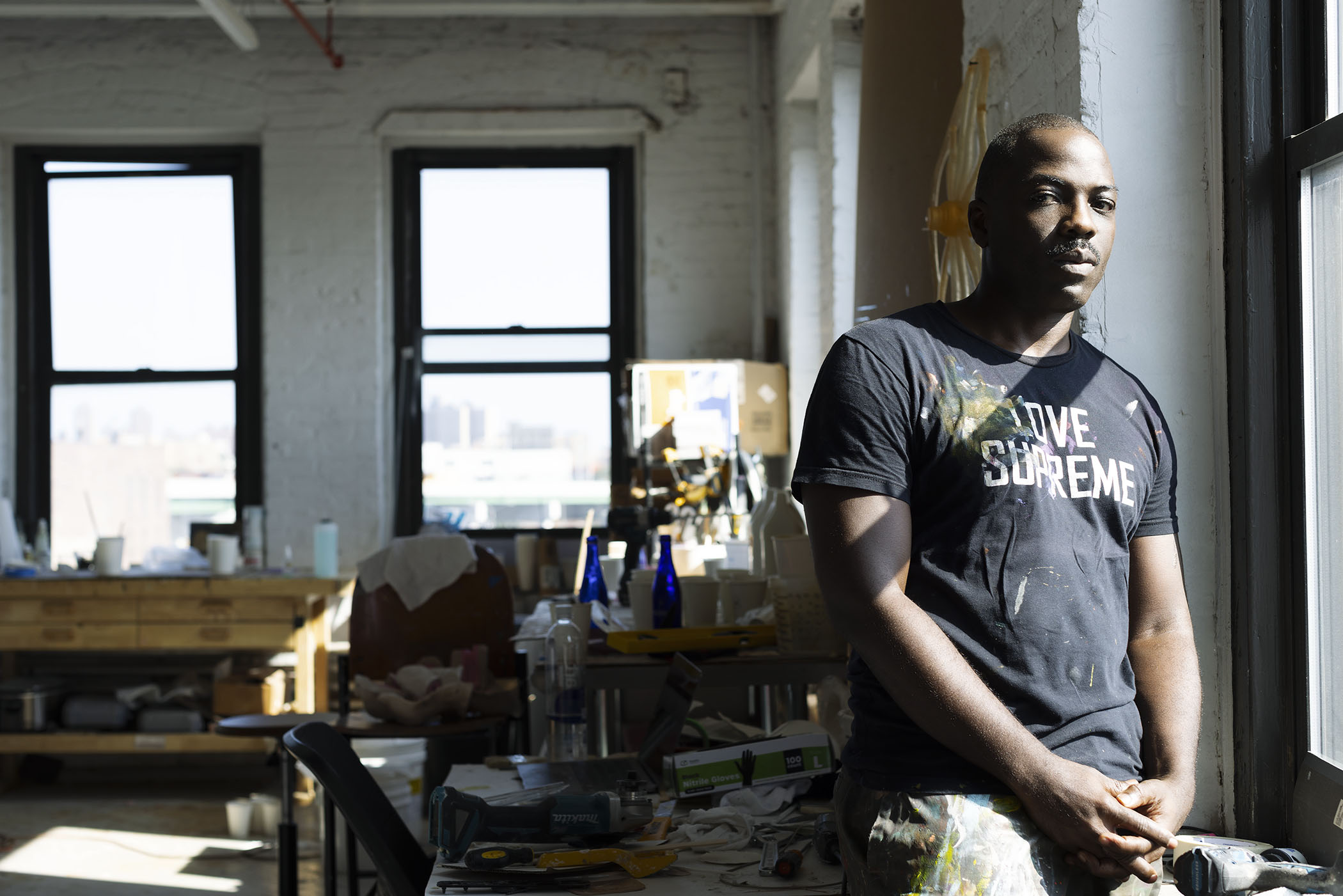 Derek Fordjour, portrait by Steve Benisty.
Derek Fordjour, portrait by Steve Benisty.
The Making of Derek Fordjour’s New Show, “SCORE”
WW: So where was your thinking at?
DF: I’ve always wanted to delineate an upper and lower plane inside of a compressed space. So as an architectural challenge, I wanted to create a gallery experience that would take you upstairs and downstairs. I enjoy the idea of moving the body through space. That was one piece, and the other was about creating a kind of arena indoors. We think about arenas and performance spaces as large and outdoors, so to miniaturize that was a formal challenge that was very attractive. And then I knew that I wanted to do more ambitious sculpture as well, and this would be the perfect occasion to do that. So that was the form.
The content that came over a period of months of deliberation is related to what I’m thinking most about on the precipice of turning 50, which I do next year. It is this reflection on life, knowing that you have a little less in the front window than you do the rear window. My son is 25, my dad is almost 80. I’ve watched family and friends deal with very real illnesses and loss very close to me. I am thinking a lot more about my own mortality and the life I’ve lived up until now.
And so I wanted to deal with that publicly, and it gave me an occasion to make very personal work that might invite others to make similar reflections in their own lives.
WW: Work that can bring people in.
DF: Yes, that’s important.
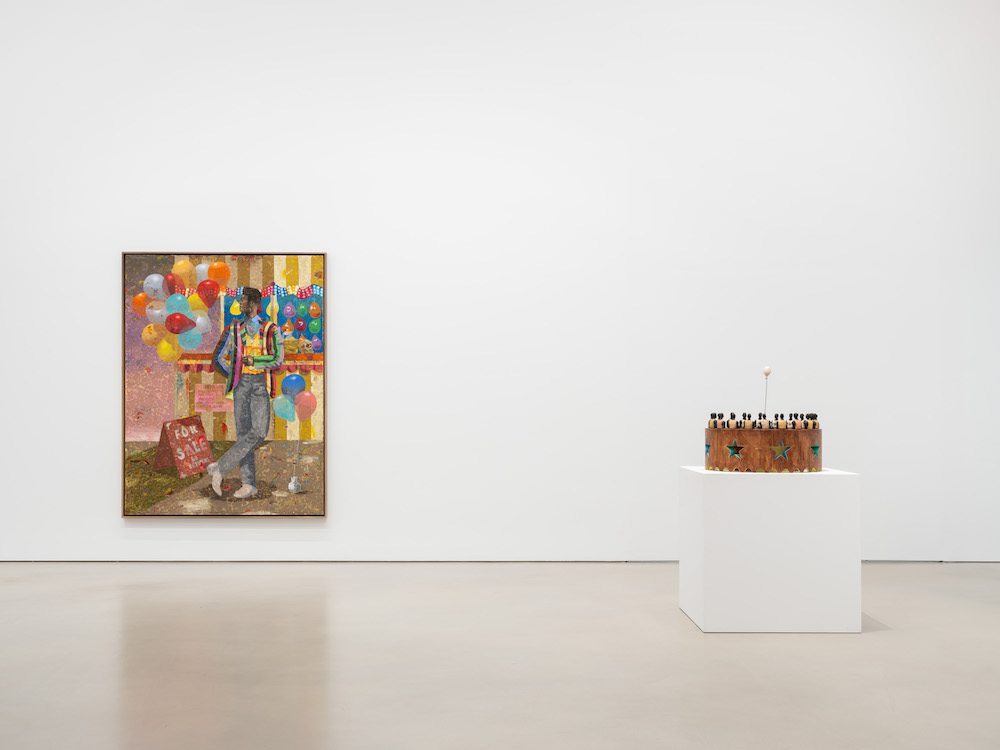 Installation view of Derek Fordjour’s “SCORE” on view at Petzel Gallery in New York.
Installation view of Derek Fordjour’s “SCORE” on view at Petzel Gallery in New York.
WW: Making paintings that were more personal, is that a first for you? Did that feel a little bit tapping into some vulnerability you hadn’t before?
DF: Definitely. My paintings deal with performance, and a lot of that is rooted in my own anxiety in performance in all the ways it shows up within my life. I enjoy the remove that painting gives me, where I don’t have to actually perform or stand in the space. That distance is a kind of protection, in one way, being able to engage with illusion. The world of painting allows me to take on so many avatars in the figures that I select in my work.
So to make work that is directly pulled from my lived experience, and that is the undeniable source, it does feel a lot more vulnerable. But I also feel that it feels right that at this time I can do that.
WW: From that more personal space, how do you want viewers to move through the exhibition?
DF: It’s about the total experience. I want to have enough offerings that someone can move through however they choose. I really don’t want to dictate that. It’s really about making a very honest offering and providing enough potential interaction in the various media that if someone was interested they have many points of entry into the work.
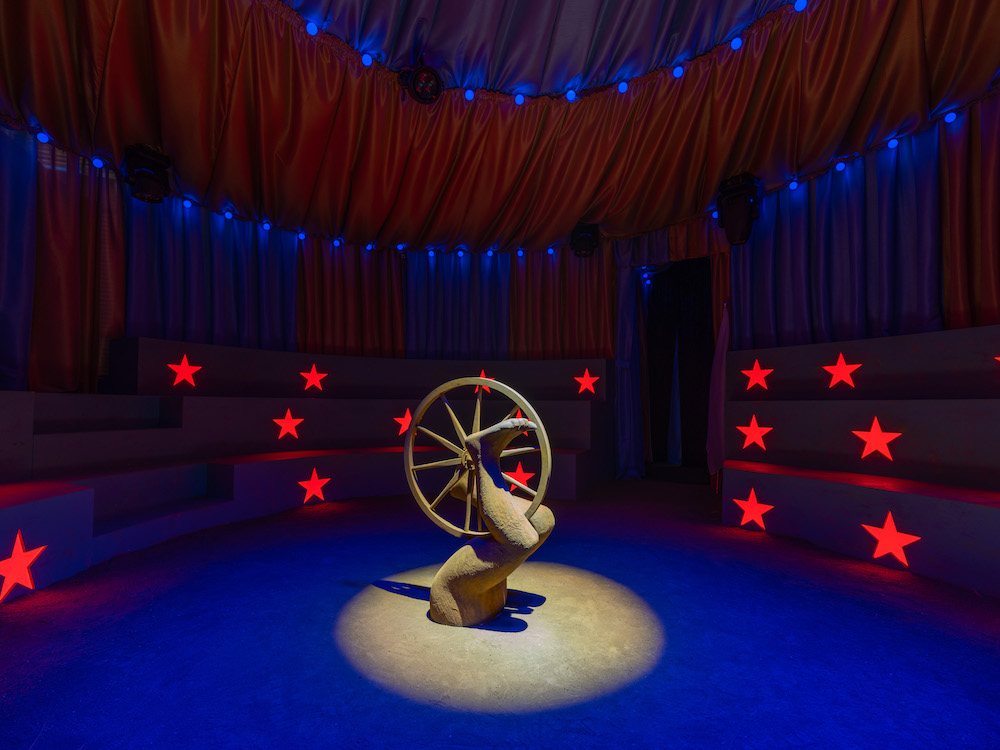 Installation view of Derek Fordjour’s “SCORE” on view at Petzel Gallery in New York.
Installation view of Derek Fordjour’s “SCORE” on view at Petzel Gallery in New York.
“Arena” Offers Live Performances Weekly
WW: Can you tell us about the performance space, “Arena,” which is a tented space with a packed dirt floor? For the performances that will take place there with dancers, you worked with choreographer Sidra Bell. What was that like?
DF: I’ve had a movement piece in mind for a number of years. I wanted to make it enriching for both of us. I wanted the experience of learning choreography or collaborating to have a direct tie to my studio practice and the works that I’m making here. The point at which we began our collaboration was very intentional because we were starting a piece, and at the same time I was starting to make paintings and sculpture.
From our first conversation, it was such a refreshing process. The idea that Sidra Bell’s, who is fantastic, her tool is her body and the bodies of others. Where she holds certain anxieties is physical and it’s in the body, where a lot of my work and my anxiety happens psychologically, emotionally. So it was a wonderful alternate form to observe starting a creative process. It puts me in the position of a student to learn, and I think that’s something that I find to be a great privilege and is something I enjoy.
The piece is entitled “Arena,” and it’s a collaboration between myself, Sidra, the wonderful ensemble of five dancers, and the musician Hannah Mayree of the Black Banjo Reclamation Project. The arena will be performed in twice daily at no cost. The piece is 29 minutes long. It is an intimate experience that can seat about 75, which is really generous and very tightly related to lots of the content in the show. It is a sculptural space that has three-tiered wooden seating structure in the round, enclosed in a tent, with a packed dirt floor on which the performers will perform. I’m interested in the sounds, sights, and smells that that can invoke.
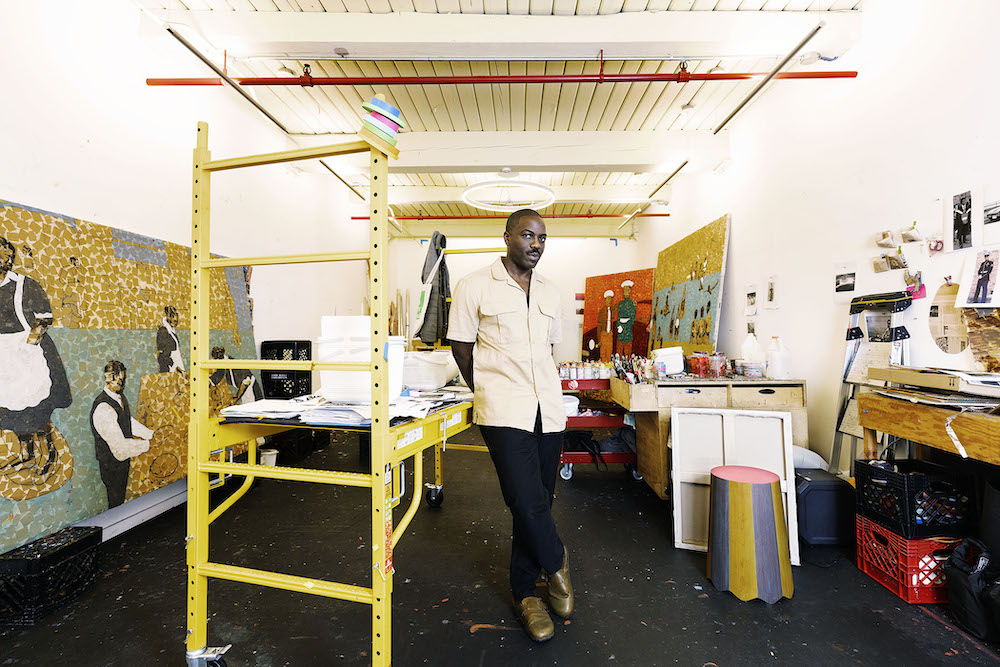 Derek Fordjour, portrait by Steve Benisty.
Derek Fordjour, portrait by Steve Benisty.
WW: Touching upon this word you used, “generosity.” Why is that important for you to offer that to the viewer?
DF: I’m learning and growing with each show. And I think from the very beginning of me exhibiting, I was interested in installation. I’m a painter, but I’m very moved by objects, I’m very moved by theatrical performance, I’m very moved by acts of creativity. This is the most honest and full expression that I can offer that reflects my internal motivations, thinking, obsessions, and curiosities. It really is more about, what’s my most full expression? It turns out that it is a generous offering, but I think that’s in comparison to what we’ve become accustomed to with gallery shows.
WW: In your painting, there is so much movement and even depiction of performance. So right there is an obvious connection between the painting, sculpture, installation, and performance.
DF: Performance is rich terrain for me to explore lots of my concerns. I had these separations where I considered my interest in theater or acting or filmmaking was a prior stage in my life. When in fact, I think what’s more accurate and what’s more honest is that I allow them to all exist on the same plane. I’m now at a point and I have a team that provides wonderful support and understanding for the vision.
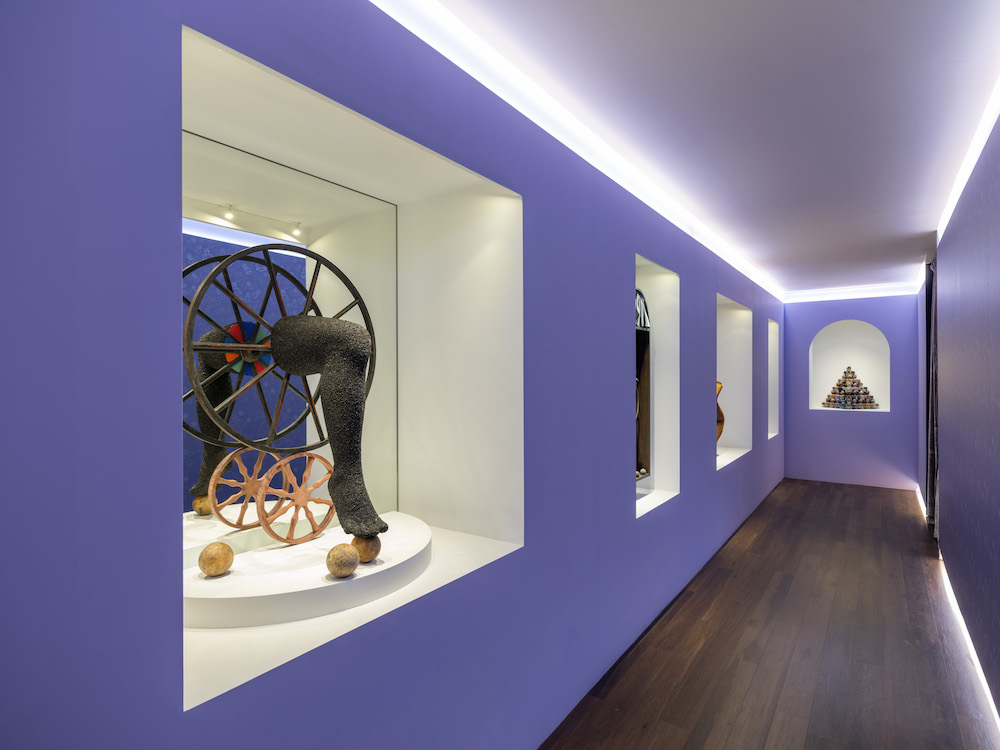 Installation view of Derek Fordjour’s “SCORE” on view at Petzel Gallery in New York.
Installation view of Derek Fordjour’s “SCORE” on view at Petzel Gallery in New York.
“Wunderkammer” is a Multi-Floor Installation
WW: Can you walk us through the other installation, the multifloor “Wunderkammer”?
DF: “Wunderkammer” means “cabinet of curiosities” in German. When you enter that installation, you ascend to an upper level that is really posh and evocative of luxury. It’s very well designed and well lit, and in each of the recesses of the corridor live sculptures made specifically for this show. When you have completed the corridor, you end up in a room with two dioramas that are kinetic sculptures: One is of rocking racehorses and the other are Black cyclists that go in and out of the frame. Hopefully, that is a magical moment.
After you spend time in that room, then you will descend into the basement area that is designed to look like you have entered the back of the gallery or backstage—somewhere you shouldn’t be. You’re kind of looking for the exit and on the way out you encounter an industrial cage wherein two actors are powering the dioramas you just saw upstairs. That is somewhat of an institutional critique wherein the top levels are more manicured and well maintained, and the sublevels out of view are where you see labor in its raw form.
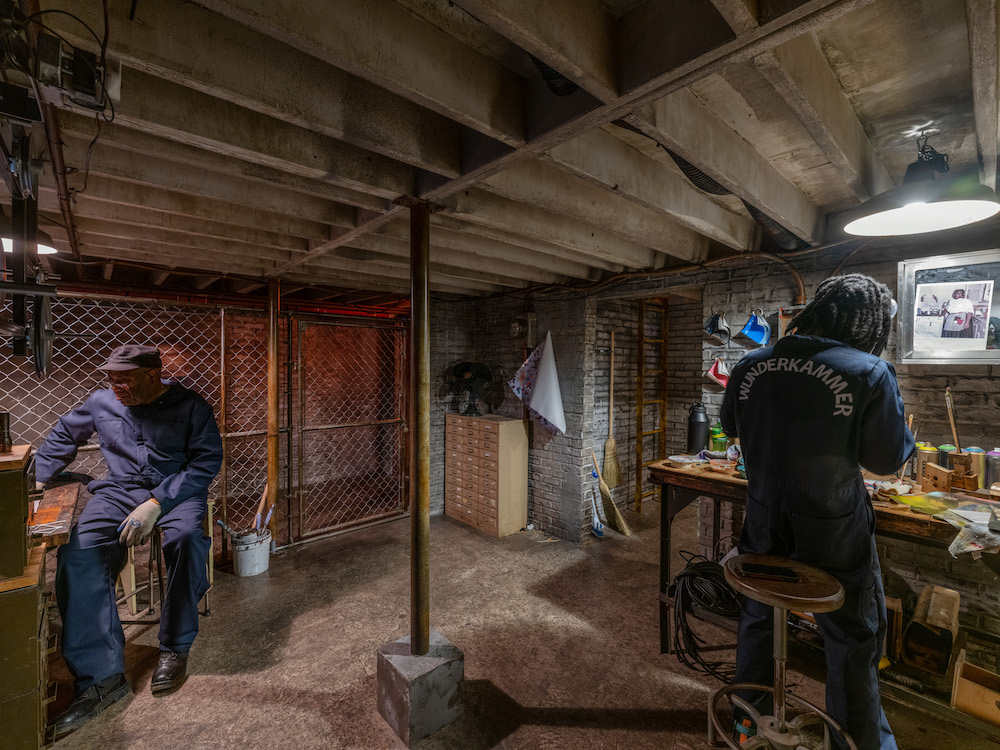 Installation view of Derek Fordjour’s “SCORE” on view at Petzel Gallery in New York.
Installation view of Derek Fordjour’s “SCORE” on view at Petzel Gallery in New York.
WW: How were you thinking about the role sculpture plays in this show and in your practice?
DF: I’ve been known as a painter, and I’ve always made and presented sculptures. I now have the ability to really dig into sculpture more substantively. Sculpture is a way for me to get closer to the poetics of my content. They are highly cathartic, and they feel very honest.
There are some pieces that include crushed glass, coal, dyed wood. I’m also working with ceramics and porcelain, which is its own universe. I’m learning so much about underglazes and firing.
WW: Have you liked working in ceramic?
DF: I have. I mean, it’s humbling, because it’s such a sensitive material and it’s also very processed-based. As I mature, thinking about how my stage in life now is relevant, I don’t think I had the patience for the process that many of these works require in order to be good. I think on some level—and I haven’t thought about this before—this show is a celebration of a certain kind of creative maturity, where I can now follow the steps and sequences and be patient and see things evolve.
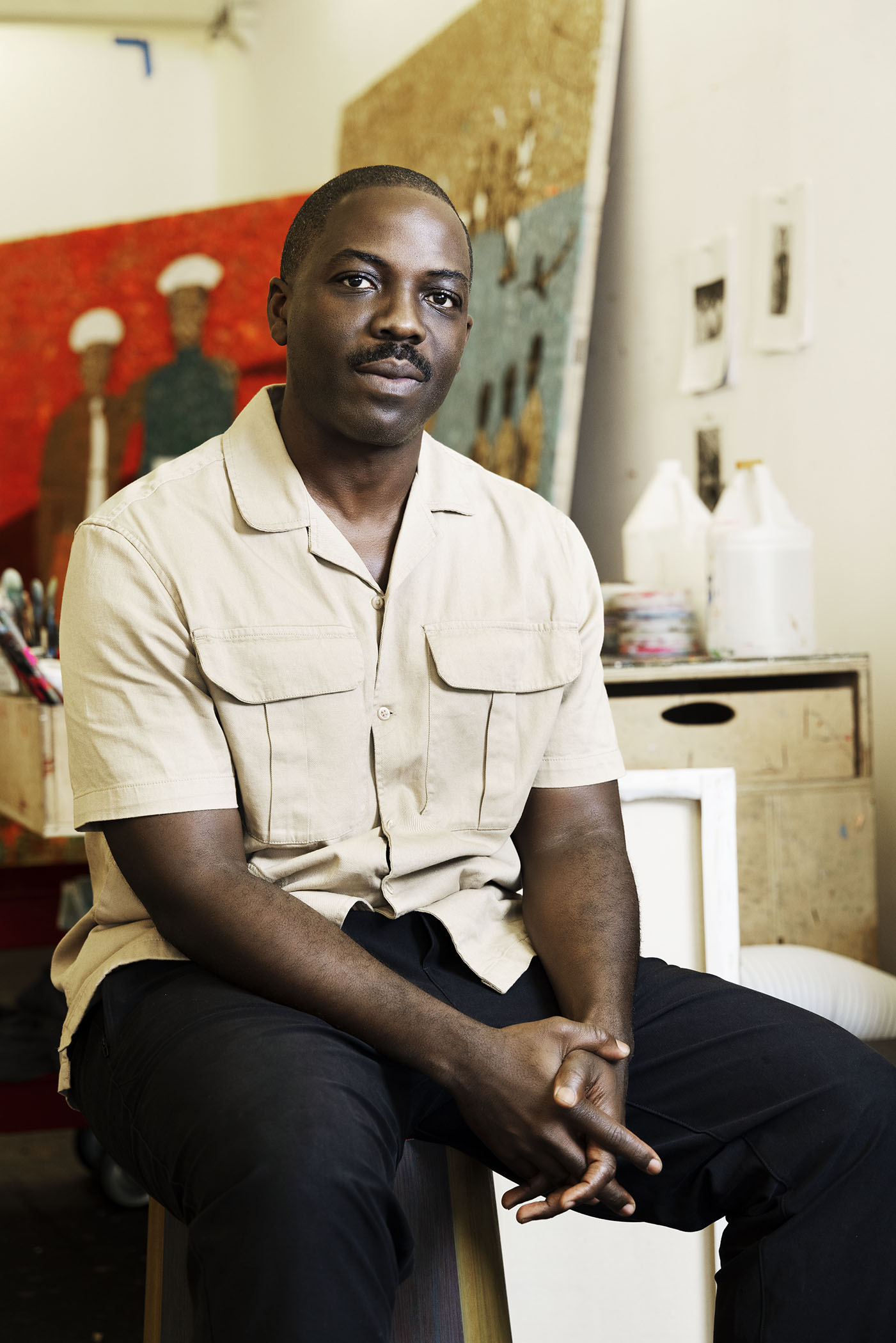 Derek Fordjour, portrait by Steve Benisty.
Derek Fordjour, portrait by Steve Benisty.
Derek Fordjour’s New Paintings on View
WW: And what can you tell us about the new paintings on view? The more personal stories we’ll see there?
DF: Right now I’m working on a painting called Confidence Man. I’m really attracted to the first three letters of the word “confidence.” It’s of a guy who is really dapper, holding tons of balloons for sale. It is a simple presentation, but for me, there was a long part of my life—probably in my thirties—where I was just selling hot air. It was all appearance and I loved my words so much, and they were backed by so little. It’s a very satisfying painting to make because it’s a way to look at myself and to celebrate the fact that I’m at a different place. And to give myself some sort of caution, that maybe this is a guy that I don’t want to be, the guy that I was. But the guy that I am is also at peace with him and can kind of laugh at him now.
There is another painting called Swimming Lessons. In our family, we lost a very dear friend who babysat my oldest brother and was a friend to all of us. His name was Russell, and when Russell passed, my older brother Ike said five words over and over. He said, “Russell taught me to swim.” And that’s what he would say in these moments of reflection. “Man, Russell taught me to swim.”
Russell had a PhD in philosophy, in theology. We had so many conversations as adults. For twenty-five years we’ve been talking to Russell, and for Ike to say repeatedly “Russell taught me to swim” prompted me to investigate a little more around the idea of swimming.
I had done some sort of nautical works, and I had a book or two about the disparities in access to public pools in Black communities and how that traces back to integration and many communities draining the pool and that kind of thing. But I was really thinking about the transfer that can happen in teaching. That what you can gift someone by giving instruction at a critical stage in development, it’s not something we take stock of, it doesn’t go on a shelf, there is no trophy, but it’s embodied. I was thinking about the empathy in our bodies. It made me think about all the gifts that we might possess and carry that we don’t give sight to. So my brother’s grieving was a way to direct me to the marvel that happens particularly with Black kids learning to swim and how empowering that can be. It’s a straightforward painting of multiple groups in a pool getting lessons, but what I’m thinking about is that transference in tutelage that’s a form of love.
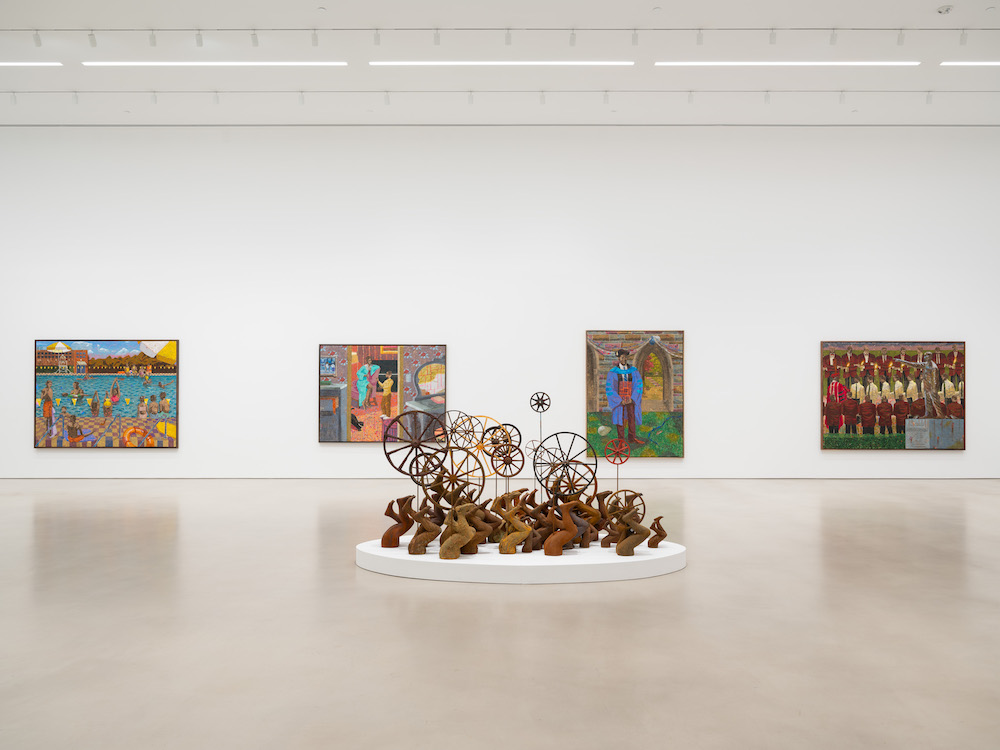 Installation view of Derek Fordjour’s “SCORE” on view at Petzel Gallery in New York.
Installation view of Derek Fordjour’s “SCORE” on view at Petzel Gallery in New York.
WW: And thinking about how we age, that you can still learn. But not everyone feels confident to be a novice in something. That makes me think of you taking on something like ceramics.
DF: That’s very true to who I am and probably the position that I’m most comfortable in. I’m skeptical of the expert. And so to be constantly learning, it does help me believe in the notion of progress, because development allows you to see various stages of growth. I don’t know if it’s my strategy for doing life, that I can continue to learn things, but I think as a creative it definitely is part of the spark that gets me going.
I’m showing my hand. You have all of my thinking. The paintings are these kinds of annotations to everything else, like pages out of my journal. I came to New York to be the next great painter, and what I thought that looked like was the smell of turpentine and old paint and dirty rags and some fantasy of a British painter in the dark. I tried that for years, and I was miserable. I worked very slow, I was tortured.
So now to have found a form that has spontaneity and invention and irreverence and imperfections, I really celebrate the arrival at this language. I don’t really need every painting to be a masterpiece. I found that pressure to be limiting and impossible. Paintings are a part of my creative life. But my life is not defined by the merits of one painting or another. And hopefully, in this new arrangement that I’ve arrived at for awhile, I’m able to make a great painting. So the joy that hopefully you can experience in creation is what gets me on the frequency that allows me to be relaxed and joyous and honest and truthful about the works I’m making. I deal with a lot of dark things in my work, and I’m probably a dark character, so my work is cathartic. But the act of painting, rather than the content of the work, deserves to have a component of enjoyment or pleasure.
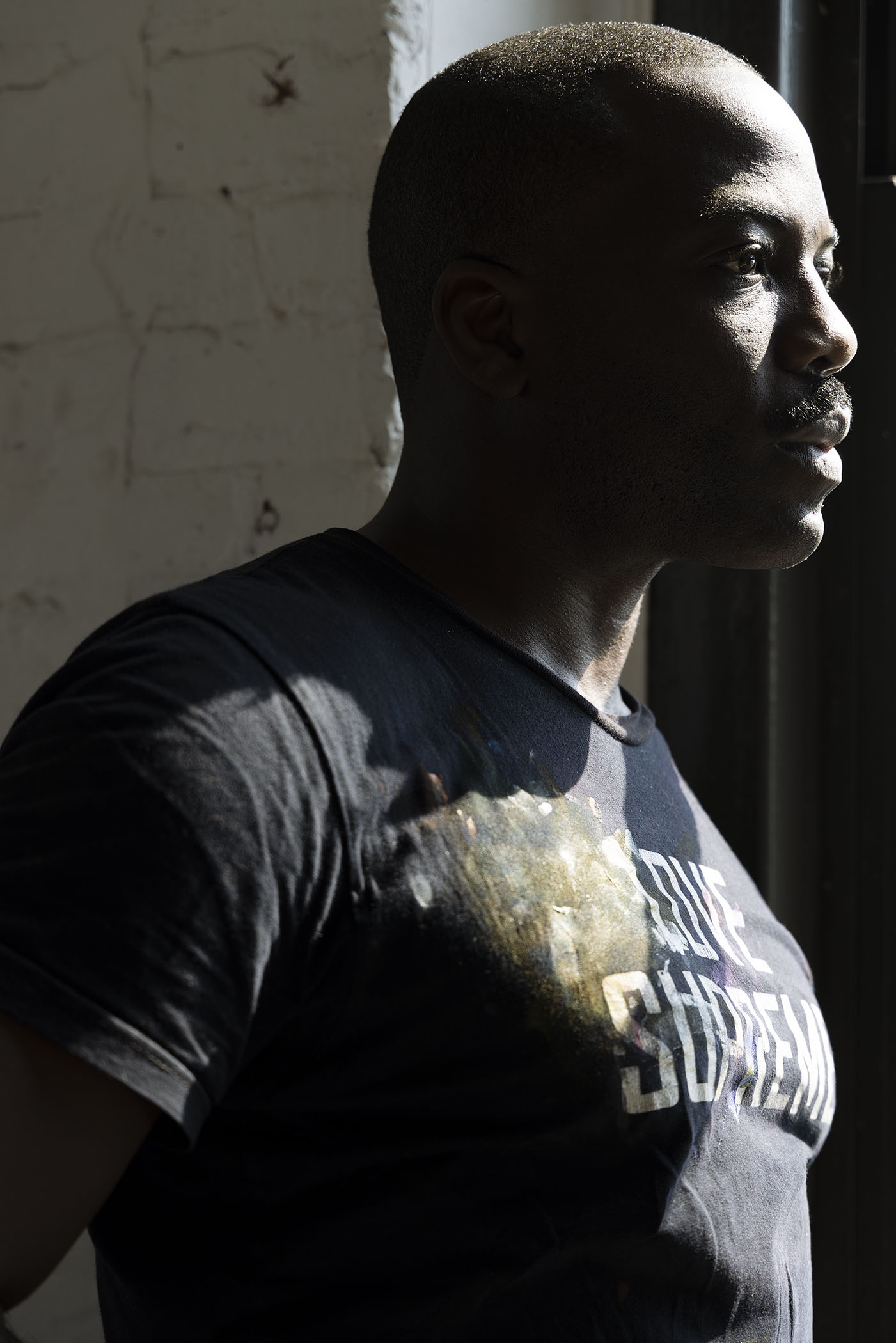 Derek Fordjour, portrait by Steve Benisty.
Derek Fordjour, portrait by Steve Benisty.






